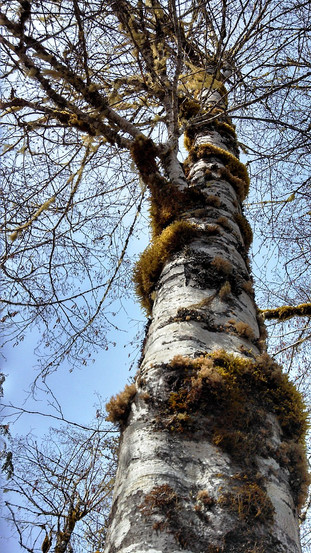Alnus rubra
- Admin
- Aug 5, 2021
- 3 min read

There are two species within the Alnus genus that California's landscape architects should know. The first is Alnus rhombifolia, with a native range throughout California, a tree once popular among designers that has subsequently fallen out of favor due to its weaker wood, uncompromising root structures, and in commercial landscapes, somewhat short life span. The other with a narrower native range is our subject, Alnus rubra, or red alder. Lesser known, too, but we might want to consider specifying this tree for cultural interests or in habitat restoration projects within the Santa Cruz Mountains up to the Oregon border and beyond, no more than ten miles from the coast.
Red alders offer some unique opportunities for cultural and scientific interpretive projects. For example, its common name refers to the red pigment of the heart and sap woods. The red wood is used for dye among Native First Peoples. In science, leaves are sensitive to overexposure from ozone, alerting scientists to imbalances in our atmosphere.
Another consideration is its weedy, rapid growth rate within native riparian corridors, a good thing when establishing a foothold along streambeds therefore doubling as a soil stabilizer by mitigating erosion. Further north where fog and rain can be more common, A. rubra could be considered for green stormwater infrastructure (GSI), capturing pollutants and cleaning runoff water. Red alders, like other riparian plants, however, are not recommended for GSI where summer water is in short supply, as dry conditions do not support their survival.
These are very specific kinds of projects that landscape architects might find themselves designing. Red alders are not recommended for more traditional design projects, such as public parks, commercial developments, or estate gardens, unless they are performing similar restorative uses. Their branches are weak, and the root systems can easily cause damage to nearby infrastructure or pavement. Yet, for other restorative projects in support of species diversity, red alders might provide an option.
facts
Botanical Name: Alnus rubra
Alnus: Traditional Latin name for alder tree
Rubra: Red, as in the interior hardwood
Common Name: Red alder
Family Name: Betulaceae
Origin: Native; Alaska to Northern California
design considerations
Positioning: Background, riparian areas
Garden Themes: Habitat, water, woodland, native, coastal
Uses: Restoration, slope/erosion stabilization/streambed embankments, shade, reforestation
identifying characteristics
Type: Deciduous tree
Form: Pyramidal, conical
Texture: Medium
Size: 90' tall in natural habitat; more commonly 50' tall, 30' wide
Outstanding Feature(s): Form
Bark: Light gray, red underneath when damaged or exposed. Smooth
Leaf:
Type: Simple
Arrangement: Alternate
Shape: Ovate
Margin: Serrate
Color: Dark green above, rust underneath. Unremarkable fall color, yellow
Surface: Smooth above, tomentose underneath
Flower: Spring. Male and female catkins.
Fruit: Summer to fall. Red to brown cones.
cultural requirements, tolerances & problems
Sunset Zones: 3-7, 14-17
USDA Zones: 6-8
Light: Sun to partial shade
WUCOLS SF Bay Area Hydro Zone: High
Soil:
Texture: Sand, loam, clay
Moisture Retention: Saturated
pH: Very acidic to neutral
Tolerances: Brackish water with some saline.
Problems:
Branch Strength: Weak
Insects: Tent caterpillars
Disease: Powdery mildew
citations & attributions
Bayton, R. (2019). The Royal Horticultural Society's the Gardener's Botanical: An Encyclopedia of Latin Plant Names. London: Mitchell Beazley.
Norris Brenzel, K. (Ed.). (2012). The New Sunset Western Garden Book. New York: Time Home Entertainment, Inc.
SelecTree. UFEI. "Alnus rubra Tree Record." 1995-2021. Cal Poly State University, San Luis Obispo. Accessed on Aug 5, 2021, from https://selectree.calpoly.edu/tree-detail/153.
Taxon Report. "Alnus rubra." Calflora, Berkeley. Accessed on August 8, 2021, from https://www.calflora.org/app/taxon?crn=253.
Water Use Classification of Landscape Species. "WUCOLS IV Plant List." University of California, Division of Agriculture and Natural Resources, Davis. Accessed on July 27, 2021.
Photos:
Female Cones: "red alder male catkins and female 'cones'" by Andrew Reding is licensed under flickr.
Leaves: "Red Alder -- leaves" by Luke McGuff is licensed under flickr.
Male Catkins: "Alnus rubra 9819" by Walter Siegmund is licensed under Wikimedia Commons.
Tree in Dormancy: "Alnus rubra (Red alder) near Chenuis Falls Trail" by brewbooks is licensed under flickr.
Tree Trunk: "Alnus rubra (Red alder) with moss and lichen" by brewbooks is licensed under flickr.
Wood Cross Section: "Alnus rubra 9853" by Walter Siegmund is licensed under Wikimedia Commons.













Comments